
| 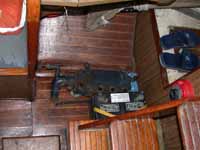
| 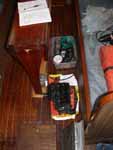
|
| | | |
After leaving Ian, Trudy and Melissa at the Belize airport, I zipped back to Moho Cay where Malakii was waiting. My plan was to head south, back to the Rio Dulce, as soon as possible. I wanted to have a week or two down there to haul her, paint the bottom, reset the prop strutt, and get her nicely put away until next year.
When I got to the marina some friends of mine, Doug and Rayene on Kristiana, let me know that there was a pretty good cold front off Cuba, headed our way, with winds of 50 knots or more expected. It wasn't supposed to get here for a couple of days.
I did a some mental gymnastics and decided I would be able to hole up someplace adequately if necessary. Weather predictions are never precise. Sometimes the storms materialize, sometimes they don't. If you waited them all out, you might never go sailing. I was happy with the seaworthiness of Malakii, less so with my own skills, but still considered them sufficient for what I might encounter. With the potential storm as a motivator, I topped off the water tanks, did a quick survey of my food supply, checked my diesel and outboard fuel, and paid my bill at the marina.
I motored out at 3pm, hoisted sail as soon as I was clear of the marina, and headed for Bluefield Range, the best anchorage south of Belize City. I motor-sailed for about an hour, then shut the engine down. I had the main double reefed, and the engine wasn't really helping any. As I was sailing along, I kept recomputing my arrival time at Bluefield Range. It would be after sunset, but maybe close enough to make it in. Bluefield has a tricky entrance, a slot between two reefs that then requires a 90 degree turn and missing two more reefs. I realized I had a trace from the previous week still on the GPS. If necessary, I could go in blind and just follow the GPS trace. I also thought of other options. I could go a bit further south, to Colson Cays, where the anchorage is a lot simpler; or I could just keep sailing. If I passed Colson, I pretty much had to sail all night. There is only one other good anchorage before Placencia, and I'd never been there and wouldn't want to attempt it in the dark. I thought quite a bit about sailing all night and the possible hazards. The two big hazards are other boat traffic, and normal navigational hazards like rocks and shoals. There is no boat traffic at night south of the main ship channel; it's too shallow and the local fishermen aren't generally out and about at night. I checked the chart more than once. It's a clear shot to Placencia.
At 18:50 I had turned onto the bearing to enter Bluefield Range. It was dark, the sun long gone, and I could barely make out the land masses of the cays. I finally decided it was too risky. If I had to do it, I could follow the GPS trace, but as I looked at it, I didn't have to do it. I turned the wheel over, headed Malakii back out into clear water, and started preparing to sail all night.
I pulled a cockpit cushion into the cockpit (I normally have them stowed while sailing), got out my alarm clock, and set a course for a point in the clear north of Placencia. The wind had moderated, and on the new heading I was on a beam reach, doing 5 to 6 knots. At that rate I would get there before the sun was up. I decided to keep the speed up, in case the wind eased, and slow down as I got closer. I tied a preventer on the boom in case the wind shifted, and made sure my harness was clipped in.
I had a wonderful sail that night, lying in the cockpit, staring up at the stars. I turned off the navigation lights for long periods of time, and learned some more constellations. I set my alarm in case I dozed off, kept an eye on the course on the GPS, and occasionally checked the compass just for grins. We sailed a straight path, no bumps, no slams, just the gentle motion of the boat and the sound of the hull slipping through the water.
I could see the glow of the few villages and one real town on the mainland as I approached them and then left them astern. I eased the sheets late in the night to slow my progress. By 07:15 I was anchored in Placencia.
I was a bit tired, but felt really great psychologically. I had one issue still to resolve -- where to check out of Belize. You can only check out in four places, and two of them were north of me. That left Big Creek, just south and west of Placencia, and Punta Gorda, where I had checked in, at the very south end of the country. The problem with Punta Gorda is that it is an open roadstead, and not a good place to have to spend any time at anchor if the weather isn't cooperating. A really bad place to be caught in a storm. I decided to check out at Big Creek, which would require paying some expensive taxis to get to the appropriate officials from my location in Placencia, or motoring up the river a mile or so. I decided to motor.
When I went to turn on the engine, it wouldn't even turn over. I tried the dedicated starting battery, thinking my all night run may have run the house battery down too far. The dedicated starter battery didn't do any better. I tried them both together. Nada.
I tried turning the crankshaft by hand, and discovered I could turn it through one compression cycle, but the on next one it wouldn't budge. And then I saw a little water come out the intake manifold and heard a sploosh.
My heart sank. I had serious engine trouble -- water in one of the cylinders. It didn't make sense to me. The engine had been running fine, albeit a bit hard to start. How had it gotten in there?
Fortunately, I knew a good mechanic from my previous engine trouble. I dinghied ashore and called Bill McKenzie. He told me to pull the injector, crank the engine until the water was out, put the injector back, start the engine and then run it for a short while to dry the cylinders.
I tried pulling the injector, but couldn't budge it. I didn't have a socket to fit -- it required a 1 1/16" deep well socket -- and I didn't have a combination wrench of that size either. So I had to use my big crescent. I was reluctant to really reef on it, fearing I would damage it beyond repair. But I needed to get the water out somehow. I tried the wrench a few more times, to no avail.
Finally, I decided to tighten the valves down on the assumption they would then not seat correctly, and I could crank the engine and force the water out that way. That seemed to work, but I couldn't get rid of all the water, and the engine certainly wouldn't start. Each time it turned over, it sounded like it was sucking more water in, not clearing water out.
I finally decided to pull the head. When I did, I found the #2 cylinder full of water. I had an eye dropper and sucked out all the water, out of the cylinders and the bolt holes. Then I filled everything with automatic transmission fluid.
Now I had a decision. I could continue on south with no engine. I knew I could sail to Livingston, Guatemala ok, but then I had to get up the Rio to the town of Fronteras / Rio Dulce. If the wind was right, I could do that; I knew it was possible because ships used to do it all the time, and my friends Sebastian and Roger had each done it a week or so before I left there a few months ago. But if the wind was wrong, or changed part way through, I would have to wait it out. Unfortunately, lying at anchor along the Rio or in the Golfete is not considered safe, particularly for a lone boat.
On top of that, I didn't know a really good engine mechanic in Guatemala, and I did know a really good one in Belize City. I guess I wasn't leaving Belize just yet. I sent email to try and find a gasget set for the engine, but to no avail. The storm was still heading my way, so I sat in Placencia and stewed for a day. It supposedly passed Belize City that night.

| 
| 
|
| | | |
I headed out at 10:15 the next morning; I had waited to check my email in town to see if I had any answers to my parts inquiries. I had hoped to be able to order them and have them waiting for me when I got back to Belize City. But I never did get any replies.
I raised the main, with one reef in in anticipation of higher winds, and headed out. I was not even clear of the Placencia anchorage when things started deteriorating further. I headed into the wind and turned on the autopilot, then started raising the jib. The boat wouldn't stay headed into the wind, and I soon discovered the drive assembly for the autopilot was out.
If there is one piece of critical electrical gear to a single hander, it is the autopilot. It allows you to keep the boat on course when you need to leave the cockpit -- to reef, do some chart work, fix something to eat, whatever.
Fortunately, I had a spare. When I bought Malakii, she came with the autopilot, two spare drive assemblies, one spare controller, and two spare belts. Taking the advice of John Vigor in The Seaworthy Offshore Sailboat, I had done pretty well at filling my black box. I had tested the spares some weeks before, and none of them worked. I had disassembled the two powerheads and scrounged enough parts to repair one. The controller I hadn't been able to deal with. Fortunately, my problem was with the power head, and my repaired spare should work. I hoped.
I locked the wheel down, and ran below and dug the spare out. I pulled the old drive assembly off, put the new one on, and voila, I was back in business. I stowed the defective drive assembly, making a mental note to see if it could be repaired.
The wind was smack on my nose. It would be a beat all the way north. I was making reasonable boat speed, but lousy progress. I had four foot seas, and apparently was fighting a southerly current. I don't know what the wind was, I'm not very good at estimating it. People later reported winds of 45-55 knots when the storm passed through, and I rode out winds at anchor off Peter's Bluff that were 35-40 and not nearly as bad as what I had this day. There were plenty of white caps, spray being blown off the waves, and foam. I was puzzled that the waves themselves weren't any larger. I enjoyed the sail, except when I screwed up and Malakii came crashing down off a wave with a slam and a shudder. My two biggest concerns were what I would do if any of the rigging gave out or the rudder broke. I figured I might be able to rig an emergency rudder of sorts with a dinghy oar, but I wasn't sure it would work very well. I thought a lot about how well I could not steer this boat by sail trim alone. I had tried it a little, and my skill was lacking, to say the least. If the rigging gave, the only tool I had to cut it free was a hack saw, which is notoriously slow. I had no reason to expect it to give out, as I had gone over it and it seemed to be in pretty good shape, but it's one of those things you think about when you are in high winds and you are taking a bit of a beating. As the day progressed, I threw another reef in the main, then switched to the #4 jib. I had hoped to get as far as Colson Cays, but it soon became apparent that wasn't a possibility.
In fact, I wasn't sure if I could reach any good anchorage. As I clawed my way north, I poured over the chart. The wind was in the worst possible direction in terms of finding a protected anchorage. Pelican Cays had great protection, but required more anchor rode than I had. The only thing that I liked was Sapodilla Lagoon.
As the day wore late, the wind eased a bit. About half way between Pelican Cays and Sapodilla Lagoon I shook out one reef in the main. As I neared Sapodilla Lagoon, I shook out the last reef.
I'd never been in Sapodilla Lagoon, but fortunately it is easily recognizable. There was a spectacular sunset going on as I approached it. Unfortunately, the spectacular sunset meant the sun was going down, and I was still about a mile too far south. I had to tack back out. With my more sheltered position, I put the #3 jib back up, leaving the #4 hanked on and tied to the deck.
I came into Sapodilla Lagoon in the dark. The protection it offered was tremendous; almost too good. It was close to dead calm, and I had to tack back and forth a half dozen times in the dark to get up into the lagoon far enough to be safe if the wind changed during the night. I steered by the red light of the depth sounder. When it hit eight feet and I could see or felt I was close to the bank in the dark, I tacked. By 18:45 I was anchored, and could relax. I fired up the stove and fixed some hot chocolate. The anchorage was pretty, from what little I could see. There were birds singing, always a good sign.
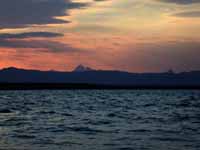
| 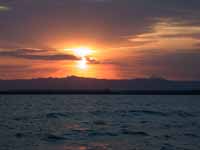
| 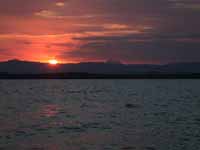
| 
|
| | | | |
I got an early start the next morning, By 07:30 I had two reefs in the main, four foot seas, and the wind still on my nose. When I tacked at Fly Range the seas were running five to six feet. I had my foul weather jacket on because it was raining off and on, spray from the foredeck would blow back and hit me, and an occasional wave slopped over and into the cockpit. I was glad there weren't any navigational hazards out where I was sailing. I had the companionway hatch all the way closed, with the bottom washboard in. There was some water in the forward bilges, probably coming in the chain pipe with the missing cap whenever we nose dived into a wave. It wasn't until the next day I thought to stuff a sock in the chain pipe.
At one point two dolphins showed up and rode the bow wave for a while. I didn't go forward to watch because I didn't trust the autopilot in the heavy wind. But it made me smile to think about it and watch what I could from the cockpit.
I was pretty used to the motion of the boat, but at 14:30 the wind did a sudden shift to the northeast. I was in a dead calm for 30 seconds or so, then it seemed like I was in the eye of a tornado, or what I would imagine it would be like in the eye of a tornado. The wind came first from one direction, then another. I couldn't keep the sails trimmed. It finally settled down to a heavy blow from the northeast. I was heading for the cut between Alligator Cay and Bluefield Range, planning on anchoring in Bluefield.
With the wind piping up I had too much sail up, but I didn't want to take anything down. I figured as soon as I got into Bluefield Range I would need all of it to maneuver, and there were boats stacked up pretty thick at the southern end of Bluefield Range. I got out the binoculars and counted at least eight masts. I tried to judge where they were, and whether or not the entrance was blocked. Everybody was holed up except me. I eased the sheets a bit and spilled some air as I worked my way east, and then north.
I came screaming into the south end of Bluefield Range with as much speed as I could put on, and not a lot of maneuvering room. There's a patch reef in the middle of the channel which I needed to get up past, one of the reasons I wanted the speed coming in; and another reef close to the eastern cay. Between the two of them you are in a pretty narrow channel. I managed to weave my way through the boats anchored at the south end. It was a bit exciting at one point because the starboard jib sheet overran on the winch on the first tack; in short order I would be on the eastern a reef. I had to head up to free it, losing a lot of boat speed and maneuverability in the process. But I got it straightened out and wove my way through the remaining boats, continuing on up to the northern cay. I dropped the hook in my favorite spot, hoping that the change in wind direction was permanent and I would continue to have good protection. It was, and I did. Phew!
The next day I made it to Peter's Bluff. So I was back in Belize City, with an engine in pieces.
During the next three weeks I called Peg and Bob and they called around and located a gasget set for me and arranged for it to be shipped down. In the mean time, we took the head in to have the valves ground. At which point we learned they were totally shot, and needed replacing. We asked the guy to do the best he could. I just wanted to get the engine running enough to get back to Rio Dulce, and would deal with rebuilding it next year. We also discovered I needed new rings. But the engine had been running, so we figured we could get it running again, and deal with the rings next year. The gasgets finally arrived, and to make it easier to work on the engine, we decided to put Malakii in the marina. Bill brought out a big 45 foot boat with four 100 HP outboards on it and we tied Malakii alongside, then dragged her into the marina. We put the engine back together, but we couldn't get it to start -- we weren't getting enough compression. Apparently the rings had set up in place, and weren't expanding. We pulled the injectors and filled the cylinders with oil and tried again. Bill could pull the injectors, where I couldn't. He had the confidence to tug a little harder, and he had the right wrench. Something I need in my tool bag. But still no luck. We had a lot better compression, but not enough. We decided to fill the cylinders with oil again, and let them soak for a day or two.
I had about resigned myself to ordering all the parts and doing a complete rebuild. It would take another two weeks or so by the time I got the parts, but I figured I had a good mechanic, and I may as well get it done right. The next night, a friend was coming in after dark in his cruiser, and I went out to help. He brought the boat alongside the dock perfectly, and I went to step down from the dock onto the deck to attach a docking line. In the moonlight, the whole deck looked flat, but in reality the outside inch or so was steeply sloped. The deck was a foot or so lower than the dock. As I stepped down, my foot slipped. Fortunately, there was a handrail on the cabin top about head high. I grabbed for it and caught my fall, but tore the heck out of my arm. I managed to get the boat tied off ok, but I knew I had hurt my arm. I did some preliminary tests, and it didn't look good. I waited until morning and tried to move my arm around again. I couldn't raise it above my waist.
It looked like I had torn the rotator cuff in my right shoulder. That was the final blow. I decided to leave Malakii in Belize and fly home. I needed to get my shoulder looked at, and it probably required surgery to repair.
So Malakii now lies in Belize City. Hopefully I will be able to return late this fall, rebuild the engine, and sail her south to Guatemala for a few months in fresh water. Then I hope to return next February and March for a few months more of exploring. There are a lot of places I didn't get to this year.

|
| |